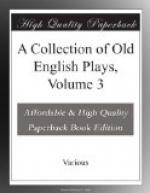“Flores. See, then, (my Lord) this Aggat that containes The image of that Goddesse and her sonne, Whom auncients held the Soveraignes of Love; See, naturally wrought out of the stone (Besides the perfect shape of every limme, Besides the wondrous life of her bright haire) A waving mantle of celestiall blew Imbroydering it selfe with flaming Starres.
Alber. Most excellent:
and see besides (my Lords)
How Cupids wings do
spring out of the stone
As if they needed not the
helpe of Art.”
Is there in the whole Greek Anthology anything more absolutely flawless?
As to the authorship of “Dr. Dodypoll” I am unable to form a conjecture. We learn from Henslowe’s Diary that a play called the “French Doctor” was popular in 1594; but we are not justified in identifying this piece with “Dr. Dodypoll.” Steevens states that the present play was composed before 1596, but he gives no authority for the statement. The song on p. 102, “What thing is love”? is found in William Drummond’s MS. extracts from Peele’s “Hunting of Cupid” (apud Dyce’s Peele).[48]
The Wisdome of Doctor Dodypoll.
As it hath bene sundrie times Acted by the Children of Powles.
LONDON Printed by Thomas Creede, for Richard Oliue, dwelling in Long Lane. 1600.
The Wisdome of Doctor Dodypoll.
Actus Prima.
A Curtaine drawne, Earle
Lassingbergh is discovered
(like a Painter) painting
Lucilia, who sits working
on a piece of Cushion worke.
Lassinberge.[49] Welcome, bright Morne, that
with thy golden rayes
Reveal’st the variant colours of the world,
Looke here and see if thou canst finde disper’st
The glorious parts of faire Lucilia:
Take[50] them and joyne them in the heavenly Spheares,
And fix them there as an eternall light
For Lovers to adore and wonder at:
And this (long since) the high Gods would have done,
But that they could not bring it back againe
When they had lost so great divinitie.




